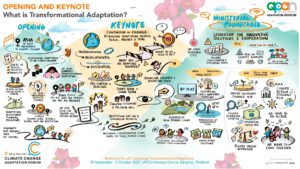What Does it Take to Catalyze Transformational Adaptation in Asia and the Pacific?
Reflections from the 9th Asia-Pacific Climate Change Adaptation Forum

How to catalyze transformational adaptation was the central, urgent question echoing through the 9th Asia-Pacific Climate Change Adaptation (APAN) Forum in Bangkok.
The theme, ‘Resilience for All: Catalyzing Transformational Adaptation’, made it clear: small, reactive tweaks are no longer enough. The consensus among government officials, researchers, and community leaders gathered was that we must move beyond coping with climate impacts and fundamentally redesign the systems we depend on.
But as the term ‘transformational adaptation’ rolled off everyone’s tongues, a question kept surfacing – what does transformation actually look like in practice?

Over the past decade, Asia-Pacific countries have made steady progress in developing national adaptation plans and local responses. Yet the growing scale and complexity of climate risks now demands transformation – deep, systemic change in how we think, plan and act. At the Forum and in our own CLARE panel, this shift was framed around three big rethinks: knowledge, governance and finance.
- From Data to Dialogue: Rethinking Knowledge: Moving from siloed, backward-looking data to co-created, forward-looking insights. This means integrating health, weather, and community data or using participatory planning to connect global models with local realities. The focus is no longer just on what data tells us, but on who shapes it, and how it’s used.
- From Control to Collaboration: Rethinking Governance: Shifting from top-down control to inclusive, co-owned governance. This requires bringing youth and local communities into national planning and recognizing Indigenous knowledge as central to decision-making. Governance for transformation means shifting from command to collaboration – from institutions that deliver change to systems that enable shared leadership.
- From Projects to Programmes: Rethinking Finance: Moving from siloed projects to systemic, program-based finance that embeds adaptation in national budgets. Participants asked tough questions: where is the money going? What is it achieving? The consensus was clear – finance must reach the most vulnerable groups and support sustained, long-term change, not just one-off interventions.
From Theory to Action: Our View from the Field
These ideas sound right in theory, but what do they look like in practice?
This is precisely what we explored in our panel session, “Enablers and Barriers to Transformational Adaptation”, hosted under the CLARE programme. Practitioners and researchers shared insights from 6 CLARE projects across Asia – including CLARE-ASEAN (Southeast Asia), SUCCESS (Bangladesh, India, Nepal and Bhutan), CLARITY (India), iCRA (Nepal), ClimateREEFS (Philippines and Indonesia) and the Innovative Facilitation project (Bangladesh, Nepal and the Philippines). Together, they show that transformation isn’t about technology or tools alone – it’s about mindsets, policies, and practices.

- In Bangladesh, SUCCESS is challenging entrenched negative narratives by reframing migration not as a failure, but as a proactive adaptation strategy that needs to be integrated into national policy.
- In the Philippines and Indonesia, ClimateREEFS is showing that “when the community leads, the ocean heals”. It empowers women and small-scale fishers through savings clubs and behavior-change campaigns to lead marine conservation efforts.
- In India, CLARITY reminds us that while “sequencing [adaptation steps] matters… parallel action matters more”. It works with farmers to foster peer-learning and diversify adaptation options, avoiding the trap of one-size-fits-all solutions.
- In Nepal, iCRA is demonstrating that “there is no one-size-fits-all approach”. It tailors solutions by addressing the deep, intersectional root causes of vulnerability, like caste and gender discrimination, which are essential for long-term resilience.
- In Thailand, CLARE-ASEAN is pushing for a “hazard-agnostic response to urban resilience”. It combines co-created research and policy dialogues to drive structural change in how cities plan for uncertainty
- In Bangladesh, Nepal, and the Philippines, Innovative Facilitation is tackling the “how” of participation. It moves beyond “business-as-usual workshops” by training facilitators in creative, inclusive methods to ensure marginalized voices can genuinely shape adaptation pathways.
These examples show that transformation isn’t a distant goal – it’s already taking shape in communities through collaboration and experimentation.
The 9th APAN Forum was a reminder that transformational adaptation is not just about doing more – it’s about doing more differently. It calls for learning across boundaries and keeping equity at the centre. The shift is already underway – the challenge now is not just to sustain it, but to nurture the mindset and partnerships that will turn experimentation into enduring systemic change.
To explore specific CLARE projects and key lessons from our session, visit the CLARE blog post “Enablers and Barriers to Transformational Adaptation: Insights from CLARE at the 9th APAN Forum”.
